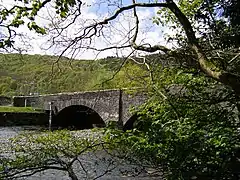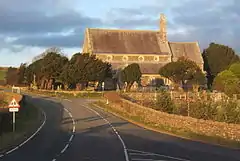Listed buildings in Millom Without
Millom Without is a civil parish in the Borough of Copeland, Cumbria, England. It contains ten listed buildings that are recorded in the National Heritage List for England. Of these, one is listed at Grade II*, the middle of the three grades, and the others are at Grade II, the lowest grade. The parish is to the north of the town of Millom in the valley of the River Duddon. It is now almost completely rural, but in the past has been the site of industry, including iron smelting fired by charcoal. There are remains of this industry in form of the ruins of a blast furnace and barns for storing charcoal, both of which are listed. The parish also contains a disused cornmill and sawmill. The other listed buildings are houses and associated structures, two bridges, a former limekiln, and a church.
Key
| Grade | Criteria[1] |
|---|---|
| II* | Particularly important buildings of more than special interest |
| II | Buildings of national importance and special interest |
Buildings
| Name and location | Photograph | Date | Notes | Grade |
|---|---|---|---|---|
| Duddon Iron Furnace 54.28400°N 3.23548°W |
 |
1736 | The remains of charcoal fired blast furnace for smelting iron. It is in stone and has a square tower-like furnace stack 40 feet (12 m) high, with wide round-headed openings. To the west is a roofless two-storey building, and to the south of this is a narrower two-storey building, also roofless. To the east of the furnace stack are the lower courses of the former blowing house, and to the south are the lower courses of the casting house. The remains are part of a scheduled monument.[2][3][4] | II* |
| Charcoal barns, Duddon Iron Furnace 54.28379°N 3.23605°W |
 |
Early 18th century | There are two charcoal barns, now ruined, one dating from later in the century. They are in stone, without roofs, forming an L-shaped plan, and there is a two-storey lean-to at the northeast. The earlier barn has a segmental opening, and the later barn has a first floor opening. The southeast wall is supported by buttresses. The barns are part of a scheduled monument.[4][5][6] | II |
| Duddon Bridge 54.28292°N 3.23147°W |
 |
18th century (probable) | The bridge carries the A595 road over the River Duddon. It is in stone, and consists of three segmental arches with triangular cutwaters on both sides. The bridge has thin voussoirs and a low plain parapet.[7] | II |
| Rawfold bridge 54.29653°N 3.23710°W |
 |
18th century (possible) | The bridge carries a road over the It is in stone, and consists of two segmental arches, that to the east being longer. The central pier stands on an outcrop of rock. The bridge has voussoirs and straight parapets.[8] | II |
| Broadgate 54.26938°N 3.25893°W |
— |
Early 19th century | A country house in stuccoed stone with a hipped slate roof, in two storeys with an attic. The south front has three bays and an entrance with a Tuscan porch. The east front has five bays, the central bay projecting forward under a gable. Most of the windows are sashes, in the south gable is an oculus, and there is a central French window in the east front.[9] | II |
| Duddon Hall 54.29535°N 3.24027°W |
 |
Early 19th century | A country house later divided into apartments. It is stuccoed, with a band, it is in two storeys, and its windows are sashes. The west front has six bays, and contains a porch with Doric half-columns and an entablature. The east front has three doorways with fanlights.[5][10] | II |
| Limekiln 54.27935°N 3.24235°W |
— |
Early 19th century (probable) | The limekiln is in stone and consists of a square structure built into the slope of the ground. On the top is a round-headed fire hole. There are also remains of the kiln at the sides.[11] | II |
| Garden temple, Duddon Hall 54.29580°N 3.24007°W |
— |
1843 | In 2007 the building was extended for residential use. The original part is in stone, and on the east front is a Corinthian portico that has a pediment with a wreath, a parapet with urns on the angles, and a datestone surmounted by a stag. The doorway has an architrave and a pediment, and the windows have segmental pediments. On the sides are Corinthian fluted pilasters and a balustraded parapet.[12][13] | II |
| Thwaites Mill 54.26888°N 3.25705°W |
— |
19th century (probable) | A former cornmill and sawmill in stone with a slate roof. The cornmill has gabled wings to the south and north, and to the east is a gabled wheelhouse containing a wheel and a concrete channel. The sawmill is to the east of this, and has a large south wing, and ball finials on the gables.[14] | II |
| St Anne's Church 54.25869°N 3.26335°W |
 |
1853–54 | The church, designed by E. G. Paley, is in stone rubble with sandstone dressings, and has a slate roof with copings and cross finials. It consists of a nave with a clerestory, a south aisle, a chancel, and a north vestry. At the eastern and of the nave is a bellcote. At the west end is a rose window, and the east window consists of a triple lancet.[15][16] | II |
References
Citations
- Historic England
- Hyde & Pevsner (2010), pp. 645–646
- Historic England & 1068577
- Historic England & 1021246
- Hyde & Pevsner (2010), p. 646
- Historic England & 1336077
- Historic England & 1138102
- Historic England & 1086625
- Historic England & 1086623
- Historic England & 1356199
- Historic England & 1067819
- Hyde & Pevsner (2010), pp. 646–647
- Historic England & 1086624
- Historic England & 1086626
- Hyde & Pevsner (2010), p. 638
- Historic England & 1336038
Sources
- Historic England, "Duddon Iron Furnace, Millom Without (1068577)", National Heritage List for England, retrieved 28 July 2016
- Historic England, "Duddon Bridge Ironworks and associated leats and Duddon Bridge Bobbin Mill and associated leats 370 metres north west of Duddon Bridge, Millom Without (1021246)", National Heritage List for England, retrieved 28 July 2016
- Historic England, "Charcoal barns to west of Duddon Iron Furnace, Millom Without (1336077)", National Heritage List for England, retrieved 29 July 2016
- Historic England, "Duddon bridge, Millom Without (1138102)", National Heritage List for England, retrieved 29 July 2016
- Historic England, "Rawfold bridge approximately 230 metres to northeast of Duddon Hall, Millom Without (1086625)", National Heritage List for England, retrieved 29 July 2016
- Historic England, "Broadgate, Millom Without (1086623)", National Heritage List for England, retrieved 28 July 2016
- Historic England, "Duddon Hall, Millom Without (1356199)", National Heritage List for England, retrieved 28 July 2016
- Historic England, "Limekiln at SD 191878, Millom Without (1067819)", National Heritage List for England, retrieved 28 July 2016
- Historic England, "Garden Temple to north of Duddon Hall, Millom Without (1086624)", National Heritage List for England, retrieved 28 July 2016
- Historic England, "Thwaites Mill, Millom Without (1086626)", National Heritage List for England, retrieved 29 July 2016
- Historic England, "Church of St Anne, Millom Without (1336038)", National Heritage List for England, retrieved 29 July 2016
- Historic England, Listed Buildings, retrieved 28 July 2016
- Hyde, Matthew; Pevsner, Nikolaus (2010) [1967], Cumbria, The Buildings of England, New Haven and London: Yale University Press, ISBN 978-0-300-12663-1